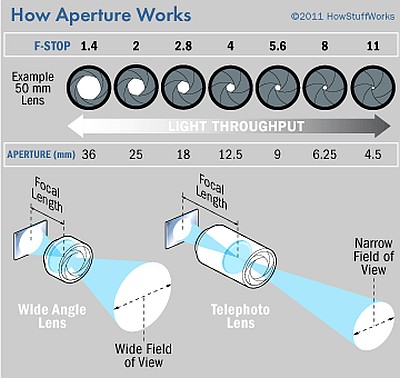In consumer optical products — most commonly cameras — aperture describes the size of the hole that lets light into a device. Cameras use mechanical diaphragms to control how much light passes into the camera body and strikes the image sensor or film. That diaphragm works a lot like the irises in your eyes; it contracts or expands depending on how much light is needed. Aperture refers to the diameter of the opening. It’s like the dark, black pupils of your eyes, the actual orifice that lets light pour through.
Cameras are by far the most common device that most of us use when dealing with the rules of aperture. However, there are plenty of other examples, such as microscopes and lasers, that are equally dependent on aperture diameter. Telescopes and aperture principles are tightly intertwined, too. Later, we’ll show you how a bigger aperture can help your telescope make Jupiter look like Jupiter instead of a blurry version of Saturn.
Keep reading to get an even better understanding of just how important the subject of a simple opening — aperture — is to photography, and to our wide world of optical devices.
Aperture in Photography
Whether you shoot film or digital, your camera acquires images through the interplay of three primary exposure settings — shutter speed, ISO (International Organization for Standardization) setting or film speed, and, you guessed it, aperture. All of these terms are critical to fully understanding aperture, so check out related articles such as What is ISO speed?, 10 Important Photography Terms and How Cameras Work.
The exposure settings you choose dictate both the duration and the amount of light entering the camera. Shutter speed controls duration, while aperture allows you to adjust the volume. The larger the aperture diameter is, the greater the amount of light flowing through the camera’s lens, which lets you control aperture size.
Different lenses have their own range of aperture settings. If you’ve ever examined camera specifications, you’ve undoubtedly seen alphanumeric symbols like f/1.4, f/5.6 and f/22. Each of these numbers correlates to a specific lens aperture size, or f-stop. F-stop numbers are fractions that tell you the exact diameter of the aperture at a given f-stop setting. The system is a bit counterintuitive, though, because smaller numbers indicate a larger aperture and larger numbers correspond to smaller openings.
Manufacturers calculate f-stop numbers for a particular lens by dividing its focal length by the aperture’s diameter. Focal length determines field of view, which varies from lens to lens. A wide angle lens — for instance, a 24mm lens — has a very broad field of view and is often used for landscape photography. A telephoto lens, for example, a 500mm lens, has a much longer focal length and a narrower field of view. And zoom lenses (such as a 70-200mm lens) let you twist the lens to move through a range of focal lengths.
Focal length is always measured in millimeters and often printed on the lens or camera body. By doing a bit of math, you can calculate the aperture size for a particular focal length. If you have a 100mm lens with the f-stop set to f/4, the size of the aperture would be 25mm.
Regardless of the focal length of the lens you’re using, you now know that by changing the f-stop, you’re altering the volume of light that passes through the lens. If fractions and f-stops aren’t your thing, don’t worry. You can still learn to change aperture settings to amazing effect using a few settings on your camera.
For more Detail: How Aperture Works

